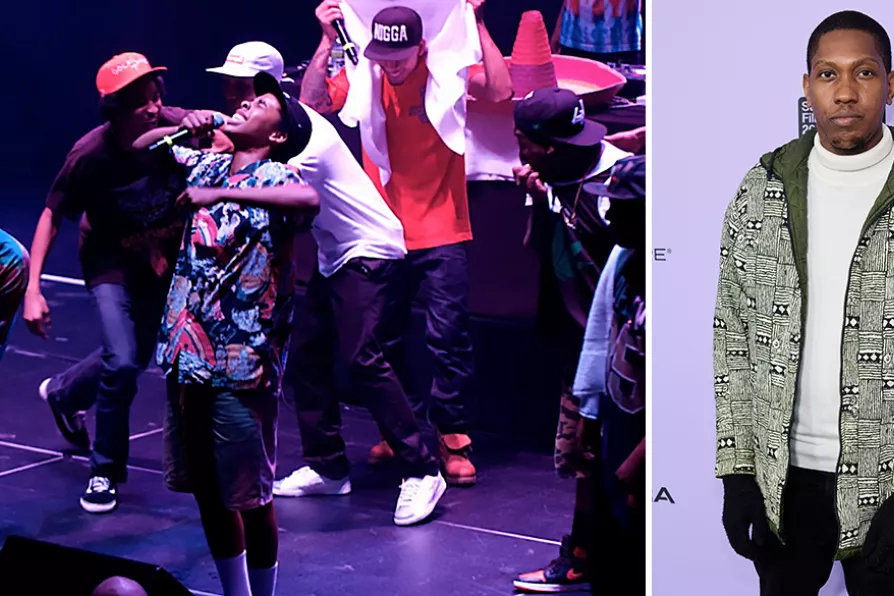JAN WOOLF finds out where she came from and where she’s going amid Pete Townsend’s tribute to 1970s youth culture

 (L) Earl Sweatshirt performing with the rest of Odd Future in March 2012; (R) Kemba
(L) Earl Sweatshirt performing with the rest of Odd Future in March 2012; (R) Kemba
I HEARD a rapper’s verse a while ago that stopped me in my tracks. The artist was Kemba and the song, Daemons, featured on the posthumous album Bad Vibes Forever (2019), by the conflicted and gifted artist XXXTentacion.
What struck me about Kemba’s verse was the way it was performed. There was an urgency in his voice, a wavering tone as if delivered in a state of panic or paranoia. It gave the impression of a man on the edge — compounded by Kemba’s harrowing recollection of how addiction, loss, poverty and crime had negatively affected his young mind.
As a practitioner of rap, I’ve long been aware the MCs I relate to most are the ones who articulate trauma and vulnerability in their work. And this is where I believe they make the most difference to their listeners’ lives.
When it’s done well and delivered with integrity, rap can offer a cathartic experience for both speaker and listener. This phenomenon is a special form of what rap researcher David Diallo defines as “call and response” — a technique embedded in rap music since its origins.
Kemba’s Daemons verse had a profound impact on me, and got me thinking about how other rappers articulate pain and trauma in their lyrical performances.
Rap music is an open-source culture that borrows from a plethora of cultural influences. As well as external forms of high and low culture, rappers often borrow freely from each other’s words and ideas.
As Adam Bradley, an expert in rap lyrics, puts it: “Imitation in an artistic context” can be seen as an act of “charging another’s words with your own creativity and, in the process, creating something that is at once neither theirs nor yours, yet somehow both.”
This process is clearly demonstrated in Kemba’s verse on Daemons, which shares stark similarities in performance style to the first verse of Kendrick Lamar’s m.A.A.d city (2012). When listening to the tracks back to back, the sense of panic in both artists’ voices stands out for comparison.
By borrowing this performance style, Kemba positions himself alongside Lamar as a “conscious rap” lyricist. Kemba shows he is attuned to his own emotional vulnerabilities and is using his music as a therapeutic platform for personal growth.
The clearest indication of how he engages with rap as a form of catharsis is how his verse concludes — by highlighting the difficulty of expressing trauma in such a public way:
“Just give me one damn minute, this shit is hard for me/ I lost my whole damn mama, I lost a part of me/ She lost her whole damn life from symptoms of poverty.”
Then, two lines later, Kemba illustrates an understanding of the healing properties of rap. His voice and cadence relax, the wavering, panicked tone no longer discernible, as his perspective shifts to one of resolution and positivity for the future:
“It was nonstop for me, no one is stoppin’ me/ Either fulfil myself or be a self-fulfillin’ prophecy/ This just how I introduce myself properly/ Kemba.”
By literally signing off after laying his cards on the table, Kemba shows how important an act of self-exposure such as this can be for a rap artist. He also shows an awareness of how it can form emotional and intellectual bonds between listener and speaker.
Some of the most effective artists practising rap as a form of healing are Earl Sweatshirt and the emerging talents MIKE and Navy Blue.
These rappers have been making music that prioritises feeling over technicality for years. As music editor Sheldon Pearce puts it, they prioritise “mood over meaning.”
Earl Sweatshirt nods to this idea in his hypnotic and clouded song Shattered Dreams (2018), saying “it’s a feelin’.” MIKE does the same in his track More Gifts (2020), in which he notes his reliance on emotional distress and painful memory to help him create rap: “To put the work in, I gotta get to hurtin’ a bit.”
It’s safe to say that Kemba, Earl Sweatshirt and MIKE consider “hurt” a key ingredient to the creation of their art.
Take MIKE’s Like My Mama, featuring Navy Blue (2022). In the track, Navy Blue eschews sonic clarity, transparency of meaning or technical ability and instead offers a highly intimate spoken portrait of recent trauma, culminating in an audible expression of emotion as he repeats the concluding phrase: “Then came the hurt.”
Songs like this clearly weren’t created to showcase technical or sonic prowess, but instead aim to alleviate pain and struggle in positive, healthy ways. As Earl Sweatshirt put it during an interview with his mother for Billboard, this kind of rap “is not explicitly shiny or for sale — the goal of it isn’t to sell … Rap helps me figure out life, it’s the medium I use to sort life out.”
The process of using recollection of painful memories as a catalyst for artistic expression has its roots in blues music. As the author and critic Ralph Ellison explains: “The blues is an impulse to keep the painful details and episodes of a brutal experience alive in one’s aching consciousness — to finger its jagged grain and transcend it.”
Following this impulse, artists such as Kemba, Earl Sweatshirt, MIKE and Navy Blue keep these “brutal experiences alive” in their music as a means of aiding the healing process for their own psychological scars.
Paul Stephen Adey is a rap lyricist and lecturer in Music Performance at Confetti Institute of Creative Technology, Nottingham Trent University
This article is republished from The Conversation














